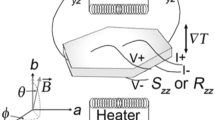Abstract:
The electronic structure of the quasi two-dimensional (2D) organic superconductor -(ET)2SF5CH2CF2SO3 was examined by measuring Shubnikov-de Haas (SdH) and angle-dependent magnetoresistance (AMRO) oscillations and by comparing with electronic band-structure calculations. The SdH oscillation frequencies follow the angular dependence expected for a 2D Fermi surface (FS), and the observed fundamental frequency shows that the 2D FS is 5% of the first Brillouin zone in size. The AMRO data indicate that the shape of the 2D FS is significantly non-circular. The calculated electronic structure has a 2D FS in general agreement with experiment. From the temperature and angular dependence of the SdH amplitude, the cyclotron and band effective masses were estimated to be and ,where g is the conduction electron g factor and the free electron mass. The band effective mass is estimated to be from the calculated electronic band structure.
Similar content being viewed by others
Author information
Authors and Affiliations
Additional information
Received: 3 March 1997 / Revised: 5 May 1997 / Received in final form: 5 November 1997 / Accepted: 10 November 1997
Rights and permissions
About this article
Cite this article
Beckmann, D., Wanka, S., Wosnitza, J. et al. Characterization of the Fermi surface of the organic superconductor - by measurements of Shubnikov-de Haas and angle-dependent magnetoresistance oscillations and by electronic band-structure calculations. Eur. Phys. J. B 1, 295–300 (1998). https://doi.org/10.1007/s100510050185
Issue Date:
DOI: https://doi.org/10.1007/s100510050185




